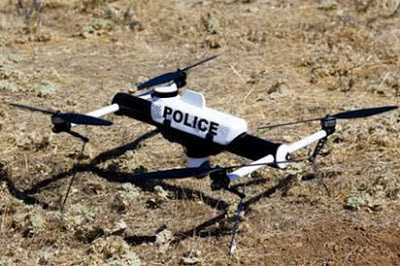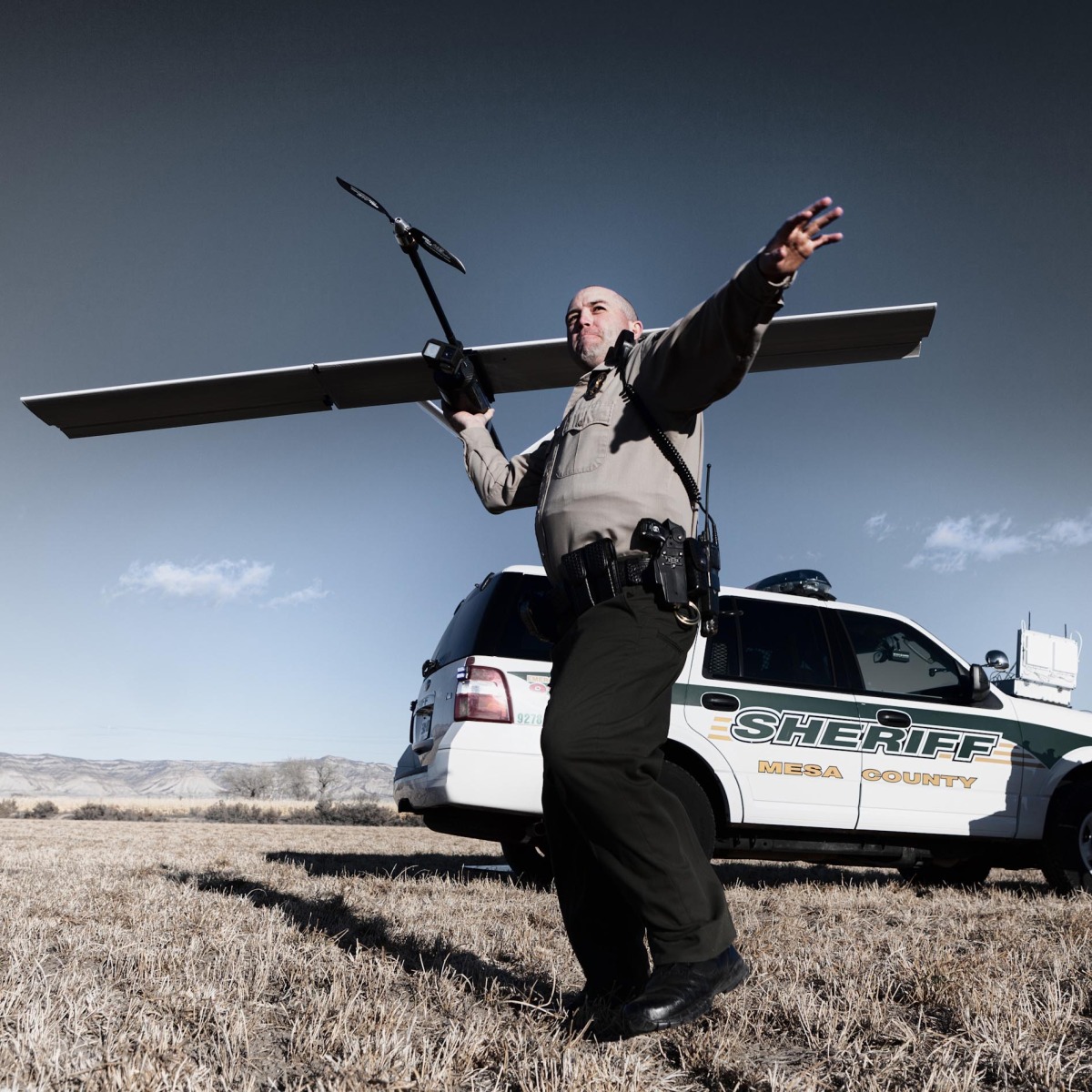Unmanned Aircraft Systems (UAS) Guidebook in Development
Unmanned Aircraft Systems (UAS) are continuing their climb in popularity and becoming a 'game changer' for domestic policing in the United States.1 Given their accessibility, cost, size, weight, portability, and payload possibilities, UAS could become universal across police agencies. With small UAS able to fit into the trunk of a patrol car but costing thousands of dollars less than a patrol car or helicopter, they can be especially appealing to budget-strapped agencies.2 Add the fact that a UAS can fly into dangerous spaces without endangering the life of an officer, and UAS secure their position as a valuable tool for police operations.
Police agencies like the Mesa County (Colorado) Sheriff's Office have already provided examples of using UAS as a life-saving and cost-cutting tool in response to traffic accidents and fires and for suspect apprehension.3 In Canada, the Royal Canadian Mounted Police in Saskatchewan used UAS to locate a disoriented traffic accident victim.4 Built with optical devices providing high-resolution videos and still images, enhancements such as thermal imaging and night vision, acoustical and tracking devices, and olfactory bio-surveillance systems, a UAS can help police maintain situational awareness and accomplish life-saving and staff-hungry missions such as the following:
- Search and rescue missions
- Missing person searches
- Hostage/barricade response
- Crisis management
- Active shooter response
- Criminal investigations
- Traffic accident analysis
- Aerial crime scene photography
- Chemical, biological, radiological, nuclear, and explosive (CBRNE) detection
- Arson investigations; hot spot identification
- Structurally distressed building assessments
 The Grand Forks (North Dakota) Sheriff's Department plans to use UAS to monitor the impact of flooding on farmland.5 The Arlington (Texas) Police Department6 has progressed from a two-year UAS testing period to gaining Federal Aviation Administration (FAA) permission to use it for public safety purposes, such as searching for missing persons and emergency tactical response.7 More information about UAS capabilities and constraints is expected to come from the FAA's six designated UAS test sites as their work gets underway.8
The Grand Forks (North Dakota) Sheriff's Department plans to use UAS to monitor the impact of flooding on farmland.5 The Arlington (Texas) Police Department6 has progressed from a two-year UAS testing period to gaining Federal Aviation Administration (FAA) permission to use it for public safety purposes, such as searching for missing persons and emergency tactical response.7 More information about UAS capabilities and constraints is expected to come from the FAA's six designated UAS test sites as their work gets underway.8
Need for Guidelines under Deadline
Under the FAA Modernization and Reform Act of 2012, the FAA is required to develop a plan for the safe integration of UAS into the National Airspace System (NAS) by September 2015.9 Currently, police agencies wanting to use a UAS must submit a Certificate of Authorization (COA) application to the FAA.10 This process may change due to federal interagency efforts to streamline the approval process so as to better equip public safety agencies to respond to emergency situations.11 While the FAA and other stakeholders work on developing plans to secure the safety of UAS into the NAS, the September 2015 deadline means that state, local, and tribal police agencies may soon be looking to develop policies and procedures to safely incorporate UAS into their own space—the communities they serve.
Can UAS Coexist with Community Policing?
From an economic standpoint, the benefit from acquiring and deploying a UAS that costs hundreds of dollars less to operate than a manned aircraft seems to outweigh the cost. However, there are less tangible costs that police will need to consider prior to deploying a UAS in their community. From a community policing standpoint, domestic police deployment of UAS begs the question of how can police agencies safely deploy UAS in a manner that will preserve their hard-won community relationships? A sliver of questions to be addressed include the following:
- How can UAS deployment affect community trust in the police, and what can the police do to uphold that trust?
- How can police use UAS for life-saving missions while maintaining their commitment to procedural justice, transparency, and accountability?
- How can police agencies balance the benefit of using UAS for surveillance in a targeted public safety mission with real or perceived threats to privacy within the community?
- What technological and operational considerations should police consider before deployment?
- What are the primary community apprehensions that police are likely to encounter when planning for and deploying UAS, and how can they best address them?
In the years to come, the safe and responsible deployment of UAS will be predicated not only on vehicle airworthiness but also on the training its operators receive and the standard operating procedures employed. Guidelines are needed to help police agencies develop sound procedures and policy protocols that are consistent with community policing principles.12
New UAS Guidebook to Focus on Public Engagement
With funding from the COPS Office, the Police Foundation is developing a guidebook for law enforcement use of UAS as part of the “Community Policing and UAS Guidelines to Enhance Community Trust” project. The guidebook is intended to help law enforcement agencies understand potential costs and benefits of using UAS, legal challenges and liability issues, impact on privacy, and the collection and use of UAS-acquired data. It is also intended to provide guidelines for deploying UAS in policing scenarios in accordance with the 4th Amendment, civil liberties, and the community policing philosophy. 
A key component of the guidebook will be recommendations on how police agencies can integrate a public engagement focus into their UAS planning before deploying them. In this spirit of promoting transparency and all around myth busting, the guidebook will include talking points that agencies can use to educate and inform the public about UAS.
Developing the guidebook is a multi-stakeholder endeavor, informed by community focus groups and a cadre of subject matter experts, including representatives from the U.S. DOJ Bureau of Justice Assistance; U.S. Department of Homeland Security; the Airborne Law Enforcement Association; and the International Association of Chiefs of Police Aviation Committee, which released “Recommended Guidelines for the Use of Unmanned Aircraft“ in August 2012. While the guidebook is still in its earliest stages, it is anticipated to become available to police agencies well in advance of the FAA's September 2015 deadline for integrating UAS into the NAS. For more information about this project, please contact Police Foundation President Jim Bueermann at jbueermann@policefoundation.org or 202-833-1460.
Debra R. Cohen McCullough, PhD
Staff Writer
COPS Office
References
1 UAS and Unmanned Aerial Vehicles (UAV) are often referred to as “drones.” U.S. Department House of Representatives Committee on Homeland Security, “Subcommittee Hearing: Using Unmanned Aerial Systems Within the Homeland: Security Game Changer?” last modified July 19, 2012, http://homeland.house.gov/hearing/subcommittee-hearing-using-unmanned-aerial-systems-within-homeland-security-game-changer.2 Christopher Keating, “Public Use of Drones Gets General Assembly Scrutiny,” Government Technology, February 24, 2014, http://www.govtech.com/public-safety/Private-Public-Use-Of-Drones-Gets-General-Assembly-Scrutiny.html. Darrell Preston, “Drones Take To American Skies Police, Search Missions,” Bloomberg Business Week, May 31, 2012, http://www.businessweek.com/news/2012-05-31/drones-take-to-american-skies-on-police-search-missions.
3 Mesa County (Colorado) Sheriff's Office, “Unmanned Aerial System Team,” accessed May 8, 2014, http://sheriff.mesacounty.us/uav/.
4 Royal Canadian Mounted Police, “Single Vehicle Rollover-Saskatoon RCMP Search For Injured Driver with Unmanned Aerial Vehicle,” last modified May 9, 2013, http://www.rcmp-grc.gc.ca/sk/news-nouvelle/video-gallery/video-pages/search-rescue-eng.htm.
5 Nidhi Subbaraman,” Drones over America: How Unmanned Fliers are Already Helping Cops,” NBC News, March 20, 2013, http://www.nbcnews.com/tech/innovation/drones-over-america-how-unmanned-fliers-are-already-helping-cops-f1C9135554.
6 Susan Schrock, “FAA Approves Arlington's Drones,” Star-Telegram, March 8, 2013, http://www.star-telegram.com/2013/03/07/4668689/faa-approves-arlingtons-drones.html. Arlington Police Department, “Frequently Asked Questions about the Aviation Unit,” accessed May 8, 2014, http://www.arlingtonpd.org/aviationunit/index.html.
7 Federal Aviation Administration, “Fact Sheet-Unmanned Aircraft Systems (UAS),” last modified January 6, 2014, http://www.faa.gov/news/fact_sheets/news_story.cfm?newsId=14153.
8 The six FAA UAS test sites are the University of Alaska, the state of Nevada, New York's Griffiss International Airport, North Dakota Department of Commerce, Texas A&M University-Corpus Christi, and the Virginia Polytechnic Institute and State University (Virginia Tech). See Federal Administration Association, “Press Release - FAA Selects Unmanned Aircraft Systems Research and Test Sites,” last modified December 30, 2013, http://www.faa.gov/news/press_releases/news_story.cfm?newsId=15576.
9 FAA Modernization and Reform Act of 2012, Public Law 112-95, 112th Congress, February 14, 2012, http://www.faa.gov/regulations_policies/reauthorization/media/PLAW-112publ95[1].pdf. 10 Additional FAA requirements require UAS to weigh less than 25 pounds, be used within visual line of sight, at a maximum of 400 feet above ground level, during daylight conditions. See Federal Aviation Administration. “Fact Sheet – Unmanned Aircraft Systems (UAS),” last modified January 6, 2014, http://www.faa.gov/news/fact_sheets/news_story.cfm?newsId=14153. Federal Aviation Administration, Integration of Civil Unmanned Aircraft Systems (UAS) in the National Airspace System (NAS) Roadmap (U.S. Department of Transportation: Federal Aviation Administration, 2013), http://www.faa.gov/about/initiatives/uas/media/UAS_Roadmap_2013.pdf. Joint Planning and Development Office, Unmanned Aircraft Systems (UAS) Comprehensive Plan (U.S. Department of Transportation: Joint Planning and Development Office, 2013), http://www.faa.gov/about/office_org/headquarters_offices/agi/reports/media/UAS_Comprehensive_Plan.pdf. FAA Modernization and Reform Act of 2012, Public Law 112-95, 112th Congress, February 14, 2012, http://www.faa.gov/regulations_policies/reauthorization/media/PLAW-112publ95[1].pdf.
11 Federal Aviation Administration. “FAA Makes Progress with UAS Integration,” last modified May 14, 2012, http://www.faa.gov/news/updates/?newsId=68004.
12 Office of Community Oriented Policing Services, Community Policing Defined (U.S. Department of Justice: COPS Office, 2012). http://ric-doj.zai-inc.com/ric.php?page=detail&id=COPS-P157.
UAS Guidebook in Development | Reflections on the NIOT Gathering | Nez Perce Tribal Police Conference | LE Instructors and De-Escalation | Military and Law Enforcement | Hitting the Road with COPS
